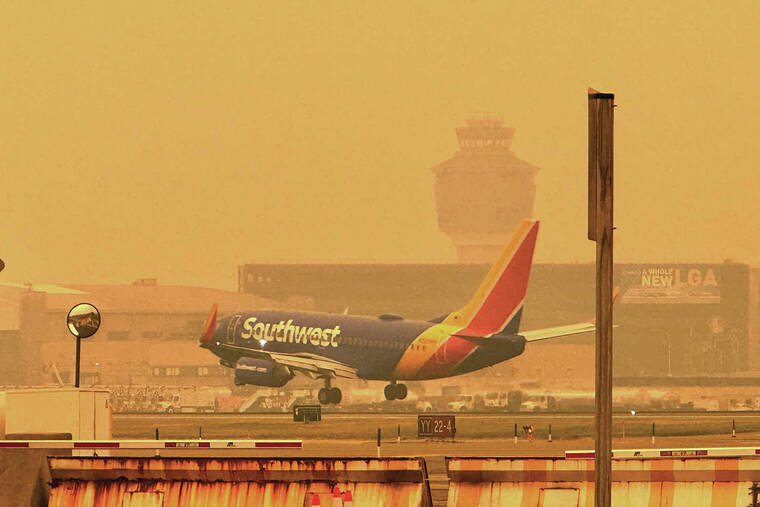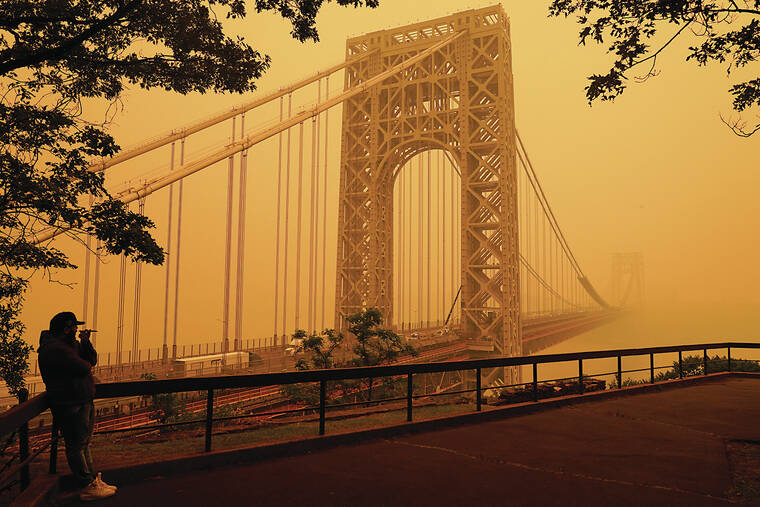Millions breathing hazardous air as smoke from Canadian wildfires streams south over US
NEW YORK — Smoke from Canadian wildfires poured into the U.S. East Coast and Midwest on Wednesday, covering the capitals of both nations in an unhealthy haze, holding up flights at major airports, postponing Major League Baseball games and prompting people to fish out pandemic-era face masks.
Canadian officials asked other countries for additional help fighting more than 400 blazes nationwide that already have displaced 20,000 people. Air with hazardous levels of pollution extended into the New York metropolitan area, central New York state and parts of Pennsylvania and New Jersey. Massive tongues of unhealthy air extended as far as North Carolina and Indiana, affecting millions of people.
“I can taste the air,” Dr. Ken Strumpf said in a Facebook post from Syracuse, New York, which was enveloped in an amber pall. The smoke, he later said by phone, even made him a bit dizzy.
The air quality index, a U.S. Environmental Protection Agency metric for air pollution, exceeded a staggering 400 at times in Syracuse, New York City and Pennsylvania’s Lehigh Valley. A level of 50 or under is considered good; anything over 300 is considered “hazardous,” when even healthy people are advised to curtail outdoor physical activity.
In Baltimore, Debbie Funk sported a blue surgical mask as she and husband, Jack Hughes, took their daily walk around Fort McHenry, a national monument overlooking the Patapsco River. The air hung thick over the water, obscuring the horizon.
“I walked outside this morning, and it was like a waft of smoke,” said Funk.
Canadian officials say this is shaping up to be the nation’s worst wildfire season ever. It started early on drier-than-usual ground and accelerated very quickly, exhausting firefighting resources across the country, fire and environmental officials said.
Smoke from the blazes in various parts of the country has been lapping into the U.S. since last month but intensified with recent fires in Quebec, where about 100 were considered out of control Wednesday — which, unsettlingly, was national Clean Air Day in Canada.
The smoke was so thick in downtown Ottawa, Canada’s capital, that office towers just across the Ottawa River were barely visible. In Toronto, Yili Ma said her hiking plans were canceled and she was forgoing restaurant patios, a beloved Canadian summer tradition.
“I put my mask away for over a year, and now I’m putting on my mask since yesterday,” the 31-year-old lamented.
Quebec Premier François Legault said the province currently has the capacity to fight about 40 fires — and the usual reinforcements from other provinces have been strained by conflagrations in Nova Scotia and elsewhere.
Canadian Interagency Forest Fire Centre spokesperson Jennifer Kamau said more than 950 firefighters and other personnel have arrived from the U.S., Australia, New Zealand and South Africa, and more are due soon.
In Washington, White House press secretary Karine Jean-Pierre said President Joe Biden has sent more than 600 firefighters and equipment to Canada. His administration has contacted some U.S. governors and local officials about providing assistance, she said.
The largest town in Northern Quebec — Chibougamau, population about 7,500 — was evacuated Tuesday, and Legault said the roughly 4,000 residents of the northern Cree town of Mistissini would likely have to leave Wednesday. But later in the day, Mistissini Chief Michael Petawabano said his community remains safe and asked residents to wait for instructions from Cree officials.
Eastern Quebec got some rain Wednesday, but Montreal-based Environment Canada meteorologist Simon Legault said no significant rain is expected for days in the remote areas of central Quebec where the wildfires are more intense.
U.S. National Weather Service meteorologist Zach Taylor said the current weather pattern in the central and eastern U.S. is essentially funneling in the smoke. Some rain should help clear the air somewhat in the Northeast and Mid-Atlantic this weekend or early next week, though more thorough relief will come from containing or extinguishing the fires, he said.
New York Gov. Kathy Hochul said 1 million N95 masks would be available at state facilities. New York City closed beaches, and Mayor Eric Adams told residents to stay indoors as much as possible as smoke smudged out the skyline. The Bronx and Central Park zoos closed early and brought their animals inside. The popular Shakespeare in the Park performance was canceled.
The Federal Aviation Administration paused some flights bound for LaGuardia Airport and slowed planes to Newark Liberty and Philadelphia because the smoke was limiting visibility. It also contributed to delayed arrivals at Dulles International Airport outside Washington, where a heavy haze shrouded the Washington Monument and forced the cancellation of outdoor tours.



